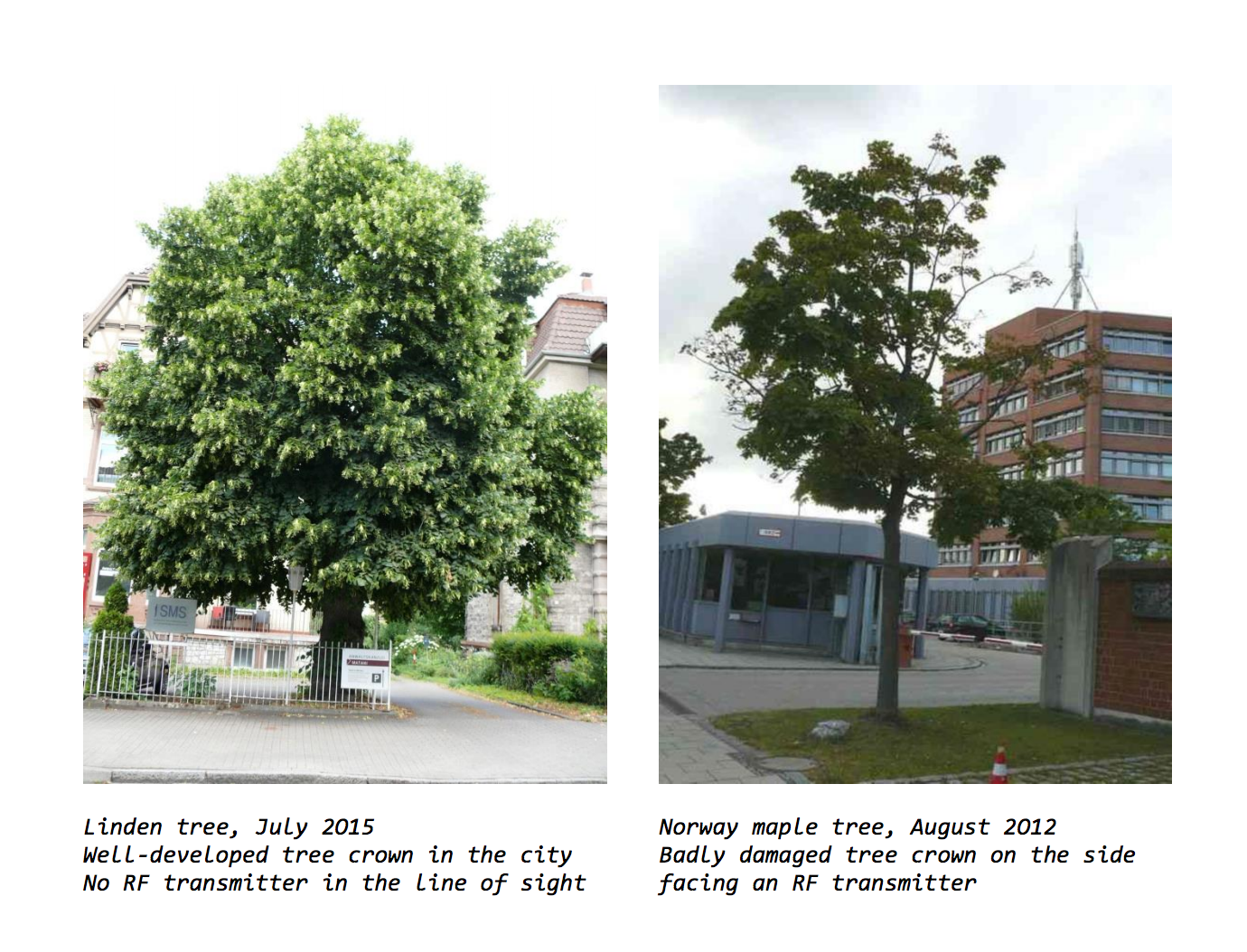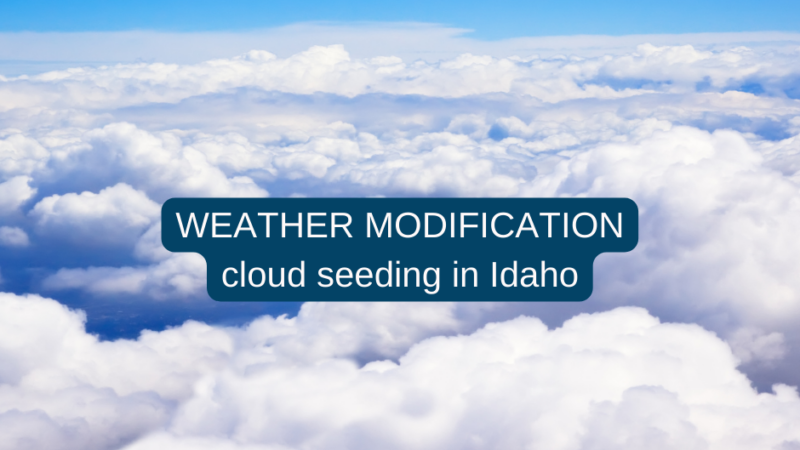Six year study proves wireless kills trees?

Wireless Kills Trees. A six-year study of trees around wireless cell towers reveals the ‘invisible’ damage of exposure to RF radiation. Radiation from wireless technology is now jeopardizing the health of our trees and other plants. “Tree damage in the vicinity of mobile phone base stations” by Waldmann-Selsam and Egar in 2013, documented suspected RF radiation related tree damage and RF radiation readings over a period of six years.
It found significantly higher RF radiation readings by damaged trees as compared to undamaged trees. Sometimes damaged areas and undamaged areas were on the same tree, in which case RF radiation levels were found to be higher near the damaged areas. Because trees are unable to move, differences in RF radiation levels from fixed sources like cell towers can result in very different RF radiation exposure micro-environments in different parts of the same tree or bush.
Researchers state “More recently, it has been shown that mortality rates of all dominant tree species in the western United States have been doubling every 17-29 years in old growth forests, and that recruitment of new trees is now occurring at a lower rate than mortality.” The aspen experiment combined with other measurement and observational studies make a compelling case that our addiction to wireless technology is killing the trees we need so much for life far faster than they can replace themselves.
In the Netherlands, because of the increased use if Wi-Fi over the last few years, a whopping 70% of urban trees are suffering from radiation poisoning, up from only 10% five years ago.
Most people don’t really stop to consider how their cell phone or other wireless devices work. They’re just “magic” and “neat” and “convenient.” If they do think about it, common perception includes these erroneous assumptions: direct communication from device to base station similar to an invisible wire or a homogeneous RF field put out by devices and towers.
Neither of these are true.
The RF fields put out by both devices and towers are not exclusively direct from device to tower. Nor are the RF fields homogeneous. There are areas of high RF concentration immediately adjacent to areas that are much lower. The exact nature of the fields depends on the transmitter configuration and use at the time. Hence, when you make a call on a cell phone or download a video on WiFi, the RF radiation (specifically, microwave radiation) used by the wireless devices goes through you and everyone around you. Which person, tree, or other creature is exposed to the most RF radiation will depend on the device, your surroundings, and the base station transmitter location. Trees cannot move when they start to “feel bad” and show signs of damage.
Tree give us oxygen and clear our air. Their health is declining visibly due to exposure.
What about the impact on human health?
These towers are being placed at schools, shopping malls, and near neighborhoods. The federal government has given cell phone companies exemption from all local ordinances as long as they can prove there is a gap in coverage. This means that even if NOBODY in the area wants it installed, they are still able to install it, and there is nothing we residents can do about it.
What about City, County and State Governments – will they listen to citizen concerns?
In Meridian and Eagle, Idaho, the West Ada school officials seemed to be unconcerned.
Could that be due to the fact that the district receives up to $2,500 a month for each cell tower site or as much as $180,000 a year. The proposed tower on an Eagle Elementary school in 2013 was opposed by the public. But in 2017 Eagle High school installed a cell tower after it was APPROVED by the school board in 2016. After being informed of the radiation testing results at the school, there has been no response or comment from the school board or the state governments.
Testing results from the Eagle High School property as reported by Lisa Doyon:
maps, results and detailed research can be found at EagleHealing,com
The radiation from cell phones, towers, WI-FI, cordless technology is all the same microwave energy just at different frequencies and levels. But the effects are the same. After the school board approved a cell tower at the local high school where my daughter attends, I rented a meter to see for myself if there was indeed radiation outside and/or inside the school. The results were shocking even to me. As much as 66,700% higher levels of radiation measured in classrooms facing the tower than what has been shown to cause biological effects on us.
And the measurements of the WI-FI/wireless devices in my house were not much better. It has caused me to make a plan to become WI-FI free in my house. It can be done even if you have laptops, tablets, and phones you want to use with the internet. It just takes a little inconvenience and a little money. But most all of us have unknowingly turned our homes into microwave ovens. The power level, though, is at a much lower level than your cooking microwave, so it’s just cooking you much slower, but is cooking you nevertheless. Click here to go right to the tower measurements. Click here to go right to the WI-FI/device measurements.
Halgamuge, M.N. “Weak radiofrequency radiation exposure from mobile phone radiation on plants.” Electromagnetic Biology and Medicine, vol. 36, no. 2, 2017, pp. 213-235.
- “Our analysis demonstrates that the data from a substantial amount of the studies on RF-EMFs from mobile phones show physiological and/or morphological effects (89.9%, p < 0.001). Additionally, our analysis of the results from these reported studies demonstrates that the maize, roselle, pea, fenugreek, duckweeds, tomato, onions and mungbean plants seem to be very sensitive to RF-EMFs. Our findings also suggest that plants seem to be more responsive to certain frequencies…”
Waldmann-Selsam, C., et al. “Radiofrequency radiation injures trees around mobile phone base stations.” Science of the Total Environment, vol. 572, 2016, pp. 554-69.
Gustavino, B., et al. “Exposure to 915 MHz radiation induces micronuclei in Vicia faba root tips.”
Mutagenesis, vol. 31, no. 2, 2016, pp. 187-92.
- The increasing use of mobile phones and wireless networks raised a great debate about the real carcinogenic potential of radiofrequency-electromagnetic field (RF-EMF) exposure associated with these devices. Conflicting results are reported by the great majority of in vivo and in vitro studies on the capability of RF-EMF exposure to induce DNA damage and mutations in mammalian systems. Aimed at understanding whether less ambiguous responses to RF-EMF exposure might be evidenced in plant systems with respect to mammalian ones, in the present work the mutagenic effect of RF-EMF has been studied through the micronucleus (MN) test in secondary roots of Vicia faba seedlings exposed to mobile phone transmission in controlled conditions, inside a transverse electro magnetic (TEM) cell.
- Exposure of roots was carried out for 72h using a continuous wave (CW) of 915 MHz radiation at three values of equivalent plane wave power densities (23, 35 and 46W/m2). The specific absorption rate (SAR) was measured with a calorimetric method and the corresponding values were found to fall in the range of 0.4-1.5W/kg.
- Results of three independent experiments show the induction of a significant increase of MN frequency after exposure, ranging from a 2.3-fold increase above the sham value, at the lowest SAR level, up to a 7-fold increase at the highest SAR. These findings are in agreement with the limited number of data on cytogenetic effects detected in other plant systems exposed to mobile phone RF-EMF frequencies and clearly show the capability of radiofrequency exposure to induce DNA damage in this eukaryotic cell system.
- It is worth noticing that this range of SAR values is well below the international limits for localised exposure (head, trunk), according to the ICNIRP guidelines (35) and IEEE std C95.1 (38), which are 10 (8.0) W/kg for occupational exposure and 2.0 (1.6) W/kg for general public exposure respectively.
Halgamuge, Malka N., See Kye Yak and Jacob L. Eberhardt. “Reduced growth of soybean seedlings after exposure to weak microwave radiation from GSM 900 mobile phone and base station.”
Bioelectromagnetics, vol. 36, no. 2, 2015, pp. 87-95.
- The aim of this work was to study possible effects of environmental radiation pollution on plants. The association between cellular telephone (short duration, higher amplitude) and base station (long duration, very low amplitude) radiation exposure and the growth rate of soybean (Glycine max) seedlings was investigated.
- The exposure to higher amplitude (41 V m−1) GSM radiation resulted in diminished outgrowth of the epicotyl. The exposure to lower amplitude (5.7 V m−1) GSM radiation did not influence outgrowth of epicotyl, hypocotyls, or roots. The exposure to higher amplitude CW radiation resulted in reduced outgrowth of the roots whereas lower CW exposure resulted in a reduced outgrowth of the hypocotyl. Soybean seedlings were also exposed for 5 days to an extremely low level of radiation (GSM 900 MHz, 0.56 V m−1) and outgrowth was studied 2 days later. Growth of epicotyl and hypocotyl was found to be reduced, whereas the outgrowth of roots was stimulated.
- Our findings indicate that the observed effects were significantly dependent on field strength as well as amplitude modulation of the applied field.
Senavirathna, M.D., et al. “Nanometer-scale elongation rate fluctuations in the Myriophyllum aquaticum (Parrot feather) stem were altered by radio-frequency electromagnetic radiation.”
Plant Signal Behav, vol. 9, no. 3, 2014.
- Statistically significant changes to this plant from a non thermal effect.
Soran, M.L., et al. “Influence of microwave frequency electromagnetic radiation on terpene emission and content in aromatic plants.”
Journal of Plant Physiology, vol. 171, no. 15, 2014, pp. 1436-43.
- Microwave irradiation resulted in thinner cell walls, smaller chloroplasts and mitochondria, and enhanced emissions of volatile compounds, in particular, monoterpenes and green leaf volatiles (GLV). These data collectively demonstrate that human-generated microwave pollution can potentially constitute a stress to the plants.
- The above is only a small sampling of the research showing biological effects at non thermal levels on living organisms.
Haggerty, Katie. “Adverse Influence of Radio Frequency Background on Trembling Aspen Seedlings.” International Journal of Forestry Research, vol 2010, no. 836278, 2010.
- “This study suggests that the RF background may have strong adverse effects on growth rate and fall anthocyanin production in aspen, and may be an underlying factor in aspen decline.”
Read more at our webpage on peer reviewed science on the environment https://ehtrust.org/science/bees-butterflies-wildlife-research-electromagnetic-fields-environment/
This article originally appeared at: https://ehtrust.org/tree-damage-caused-mobile-phone-base-stations-observation-guide-helmut-breunig/.
RESOURCE:
Photos and RF measurements by Cornelia Waldmann-Selsam Additional photos by Alfonso Balmori, Helmut Breunig, Örjan Hallberg, Volker Schorpp and Monika Schuberth-Brehm
This documentation can be found online at Kompetenzinitiative.net. We have posted the peer-reviewed research that shows that cell tower mobile phone base station radiation damages trees below this document.
Note the published article by Waldmann-Selsam, C., et al. “Radiofrequency radiation injures trees around mobile phone base stations.” Science of the Total Environment, vol. 572, 2016, pp. 554-69.




